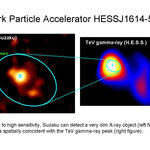Space

Four years of observations from the European Space Agency’s Integral (INTErnational Gamma-Ray Astrophysics Laboratory) satellite may have cleared up one of the most vexing mysteries in our Milky Way: the origin of a giant cloud of antimatter surrounding the galactic center.
As reported by an international team in the January 10 issue of Nature, Integral found that the cloud extends farther on the western side of the galactic center than it does on the eastern side. This imbalance matches the distribution of a population of binary star systems that contain black holes or neutron stars,…
For the first time astronomers are able to see indirect evidence of dark matter and how this invisible force impacts on the crowded and violent lives of galaxies. University of British Columbia researcher Catherine Heymans has produced the highest resolution map of dark matter ever captured before.
Scientists believe that dark matter is the invisible web that houses galaxies. And as the universe evolves, the gravitational pull of this unseen matter causes galaxies to collide and swirl into superclusters.
Heymans and the University of Nottingham’s Meghan Gray led an international team to test…

Hundreds of millions — or even billions — of years after planets would have initially formed around two unusual stars, a second wave of planetesimal and planet formation appears to be taking place, UCLA astronomers and colleagues believe.
"This is a new class of stars, ones that display conditions now ripe for formation of a second generation of planets, long, long after the stars themselves formed," said UCLA astronomy graduate student Carl Melis, who reported the findings today at the American Astronomical Society meeting in Austin, Texas.
"If we took a rocket to one of these stars and…
Using the powerful one-two combo of NASA’s Swift satellite and the Gemini Observatory, astronomers have detected a mysterious type of cosmic explosion farther back in time than ever before. The explosion, known as a short gamma-ray burst (GRB), took place 7.4 billion years ago, more than halfway back to the Big Bang.
"This discovery dramatically moves back the time at which we know short GRBs were exploding. The short burst is almost twice as far as the previous confirmed record holder," says John Graham of the Johns Hopkins University, in Baltimore, Md. Graham is presenting his group’s…

A new 11-year cycle of heightened solar activity, bringing with it increased risks for power grids, critical military, civilian and airline communications, GPS signals and even cell phones and ATM transactions, showed signs it was on its way late Thursday when the cycle’s first sunspot appeared in the sun’s Northern Hemisphere, NOAA scientists said.
“This sunspot is like the first robin of spring,” said solar physicist Douglas Biesecker of NOAA’s Space Weather Prediction Center. “In this case, it’s an early omen of solar storms that will gradually increase over the next few years.”
A sunspot…

New observations from Suzaku, a joint Japanese Aerospace Exploration Agency (JAXA) and NASA X-ray observatory, have challenged scientists’ conventional understanding of white dwarfs. Observers had believed white dwarfs were inert stellar corpses that slowly cool and fade away, but the new data tell a completely different story.
At least one white dwarf, known as AE Aquarii, emits pulses of high-energy (hard) X-rays as it whirls around on its axis. "We’re seeing behavior like the pulsar in the Crab Nebula, but we’re seeing it in a white dwarf," says Koji Mukai of NASA Goddard Space Flight…

An international team of astronomers, led by Professor Svetlana Berdyugina of ETH Zurich’s Institute of Astronomy, has for the first time ever been able to detect and monitor the visible light that is scattered in the atmosphere of an exoplanet.
Employing techniques similar to how Polaroid sunglasses filter away reflected sunlight to reduce glare, the team of scientists were able to extract polarized light to enhance the faint reflected starlight ‘glare’ from an exoplanet. As a result, the scientists could infer the size of its swollen atmosphere. They also directly traced the orbit of the…

By working in synergy with a ground-based telescope array, the joint Japanese Aerospace Exploration Agency (JAXA)/NASA Suzaku X-ray observatory is shedding new light on some of the most energetic objects in our galaxy, but objects that remain shrouded in mystery.
These cosmic powerhouses pour out vast amounts of energy, and they accelerate particles to almost the speed of light. But very little is known about these sources because they were discovered only recently. "Understanding these objects is one of the most intriguing problems in astrophysics," says Takayasu Anada of the Institute for…

Using observations from ESO’s VLT, astronomers were able for the first time to reconstruct the site of a flare on a solar-like star located 150 light years away - about ten million times further away from us than the Sun is. The study of this young star, BO Microscopii, will help scientists better understand the youth of our own star.
BO Microscopii is a young star with a mass about 90% of the mass of our Sun. It is located 150 light years away towards the Microscope constellation. 'Speedy Mic', as it is called, got its name because of its very fast rotation. The object rotates 66 times as…

UC Davis researchers have dated the earliest step in the formation of the solar system -- when microscopic interstellar dust coalesced into mountain-sized chunks of rock -- to 4,568 million years ago, within a range of about 2,080,000 years.
UC Davis postdoctoral researcher Frederic Moynier, Qing-zhu Yin, assistant professor of geology, and graduate student Benjamin Jacobsen established the dates by analyzing a particular type of meteorite, called a carbonaceous chondrite, which represents the oldest material left over from the formation of the solar system.
The physics and timing of this…